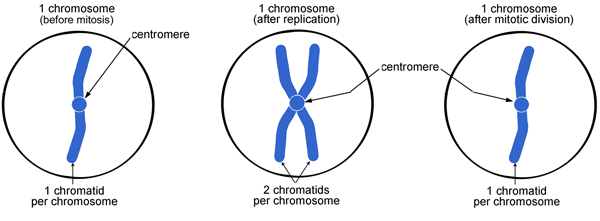
Before we discuss mitosis, let’s review the structure of DNA. Chromosomes are packaged by histone proteins into a condensed structure called chromatin. The first level of packaging is represented as the “beads-on-a-string” structure. The condensed chromatin is folded and tightly coiled, like a coiled telephone cord, allowing the cell’s DNA to be packed into the nucleus.
Before a cell can divide, it must first replicate its DNA so that each of the two daughter cells will receive a complete copy of the DNA. The two identical chromosomes that result from DNA replication are referred to as sister chromatids. Sister chromatids are held together by proteins at a region of the chromosome called the centromere.
Chromosomes undergo additional compaction at the beginning of mitosis. When fully condensed, replicated chromosomes appear as thick X-shaped structures that are readily observed under the microscope (see figure below). Chromosomes can have 1 or 2 chromatids, depending on whether they have replicated.
A chromatid is a condensed DNA subunit of a chromosome. The two chromatids of a duplicated chromosome are held together at a region of DNA called the centromere (see figure below). Centromeres are the attachment points for microtubules, which are responsible for the guiding the movement of chromosomes during mitosis and meiosis.

Most eukaryotic cells contain two sets of chromosomes, with one set originating from the father and the other from the mother. For example, every human cell has 23 pairs of chromosomes: one chromosome from each pair is inherited from the father (via the sperm), and the other is inherited from the mother (via the egg).
The figure below shows a cell that contains four chromosomes (found as two pairs); the pink chromosomes were inherited from the mother and the blue chromosomes were inherited from the father. Each chromosome contributed by the father has a corresponding chromosome that was contributed by the mother. These corresponding chromosomes, which are alike in structure and size, constitute a homologous pair (also referred to as bivalents). The DNA sequences of homologous chromosomes are usually not exactly identical.
The nuclei of most human cells contain 46 chromosomes. These 46 chromosomes consist of 23 pairs of homologous chromosomes, or homologs, meaning each of these pairs are alike, but not necessarily identical. The 23rd pair of chromosomes in humans determines sex; these two chromosomes may be very different from each other, depending on gender (XX produces females, XY produces males). The convention is to describe the chromosome number in humans as 2n = 46 because the cells are diploid, meaning they have two complete sets of chromosomes.
